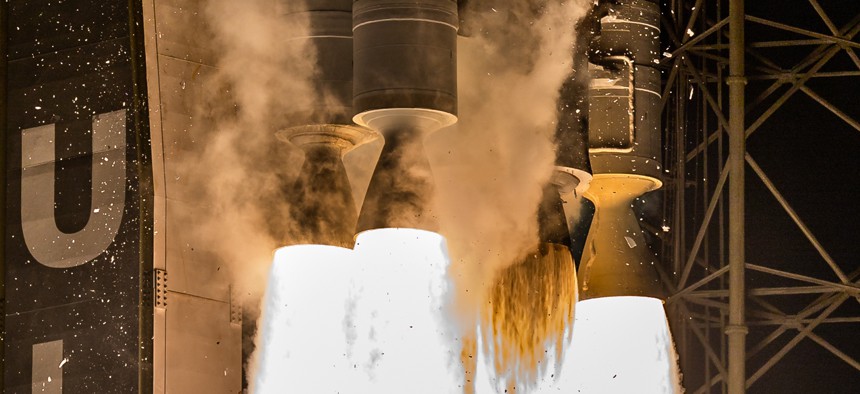
The engines of the Atlas V rocket during liftoff, Nov. 13, 2020. NurPhoto9 via Getty Images / Manuel Mazzanti
Rocket Startup Could Get Huge Boost from Lockheed Martin Buying Aerojet Rocketdyne
Ursa Major is developing a family of rocket engines for commercial and defense customers.
Lockheed Martin might not be the only benefactor if the Federal Trade Commission allows the company to buy rocket maker Aerojet Rocketdyne.
The acquisition will leave the U.S. without an independent rocket supplier at a time when Congress is pushing to eliminate Russian-made engines for U.S. rockets. Enter Ursa Major Technologies, a Colorado-based rocket startup that says it can 3D print and assemble small rockets in a matter of days, and is now working to scale its technology to build even larger ones.
“At the core, what we see is that there is a gap in the U.S. supply chain when it comes to propulsion technology for space launch and for hypersonics because we've acquired away all of the pure play propulsion providers,” said Blaine Pellicore, who oversees the company’s defense business.
Northrop Grumman’s 2018 acquisition of Orbital and Lockheed’s proposed $4.4 billion acquisition of Aerojet Rocketdyne would leave the United States without an independent rocket supplier. As this happens, Ursa Major has been proving its technology and assembling customers, including a large defense prime contractor.
“We're really the only game in town,” Pellicore said. “There's a reason we're signed with a very serious prime customer, and there's no reason why we should be signed with them except that this is the dynamic that's happening right now.”
Pellicore declined to name the company, but said consolidation within the rocket motor sector has opened doors at the Pentagon, on Capitol Hill, and with investors (Ursa Major has raised more than $56 million).
“People in the Pentagon are very concerned about the continuing consolidation across the defense industrial base,” he said. “This particular area is concerning because it's never been this bad before—it's never been this consolidated in a technology area that, I would argue, [is] even more important than it was during the Cold War.”
The company has fashioned itself as a “a pure play, vehicle agnostic, cutting edge technology company that is just focused on building the best possible engines across as many verticals as we can,” Pellicore said.
Through additive manufacturing, it can 3D print about 80 percent of the engine. All in all, it takes about two days to assemble the engine if all of the materials and parts are on hand. The entire process from getting an order, acquiring parts, building the engine, testing it, and boxing it up for shipment typically takes about six months.
“If everything's in our hands, if the supply chain has come through for us, and we have it inside Ursa Major facilities, you're talking about a two-week process of getting the engine out the door,” Pellicore said.
The company has assembled a who’s who on its board of advisors, including former NASA administrator Charles Bolden, former Northrop CEO Ronald Sugar, former Air Force acquisition chief Will Roper, and former Pentagon policy chief Michèle Flournoy.
Ursa Major sees its technology being valuable in both the commercial and defense sectors.
“Our vision is to be able to invest all of our effort into developing what will constantly be the best version of propulsion for a space launch in hypersonics,” Pellicore said. “We think it's a really important area for us as a country to keep competitive advantage when it comes to two very critical defense technology spaces.”
In addition to the 5,000 pounds of thrust engine it’s building today, called Hadley, it’s also developing a 35,000 pounds of thrust engine, called Ripley. Then there’s Samus, a 50,000 pounds of thrust engine that Pellicore said could be a “rapidly deployable replacement” for the Aerojet Rocketdyne RL10, an engine used on the upper stages of the United Launch Alliance Atlas V and Delta IV. The RL10 is also slated to be used on future rockets, including the Space Launch System being designed for human, deep space missions.
Ursa Major has sold dozens of the Hadley engines to launch companies including StratoLaunch, Generation Orbit and Phantom Space.
“It's important to have a common vehicle-agnostic engine, that an industrial base can put tanks on top of and be able to get you the type of responsive launch that you're looking for,” Pellicore said.
In addition to supplying launch companies, Ursa Major sees hypersonic weapons as an area where it can play an important role for the Pentagon.
“There's nobody that's just focusing all of their time, effort, energy, and talent on developing cutting edge next-generation propulsion systems,” Pellicore said. “When it comes to orbital space launch, and hypersonics, 70% of the effort and the magic that goes into those vehicles is in the propulsion system”
Meanwhile, the FTC is giving extra scrutiny to Lockheed Martin’s planned acquisition of Aerojet Rocketdyne.
Boeing has said Northrop Grumman’s 2018 acquisition of Orbital ATK prevented it from placing a bid to build new Intercontinental Ballistic Missiles. Northrop entered the only bid and won the $85 billion deal.
This week, Sen. Elizabeth Warren, D-Mass., called on the FTC to release the results of an investigation into whether Northrop complied with a condition of the Orbital acquisition that requires Northrop to sell rocket motors to its competitors. The result of that investigation, Warren said, should factor into the FTC’s decision about whether to approve Lockheed’s acquisition of Orbital.
“If the investigation is ongoing, then I urge the FTC and the DOD to complete that investigation and consider its findings when deciding whether to approve any similar vertical transactions, including Lockheed Martin’s proposed acquisition of Aerojet Rocketdyne,” Warren wrote in a July 16 letter to FTC Chair Lina Khan.
Raytheon Technologies, which openly opposes Lockheed’s acquisition of Aerojet, is based in Warren’s home state of Massachusetts.




